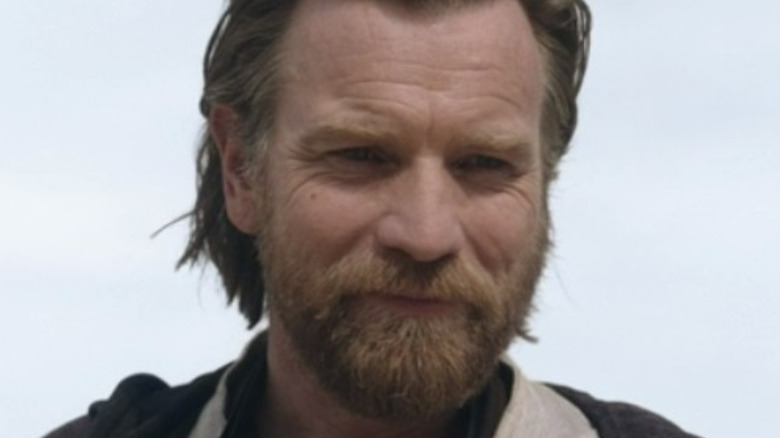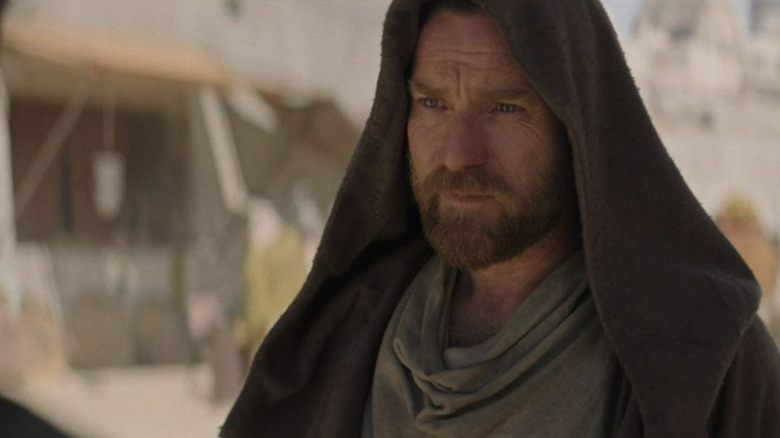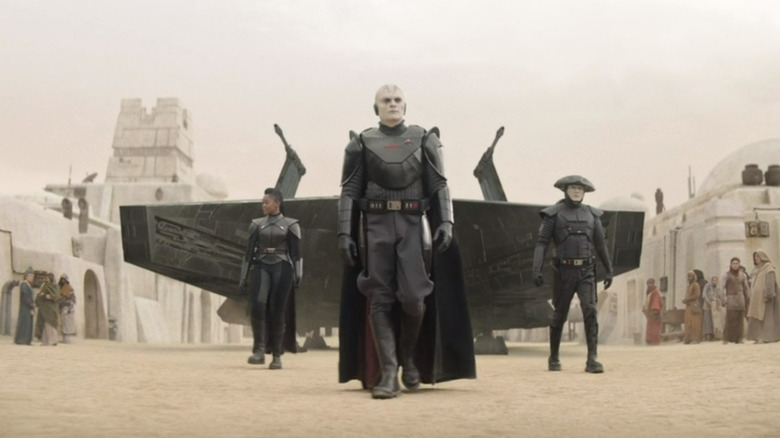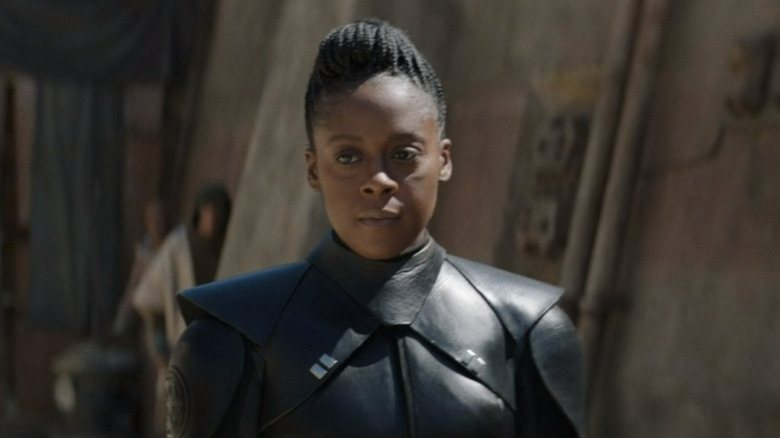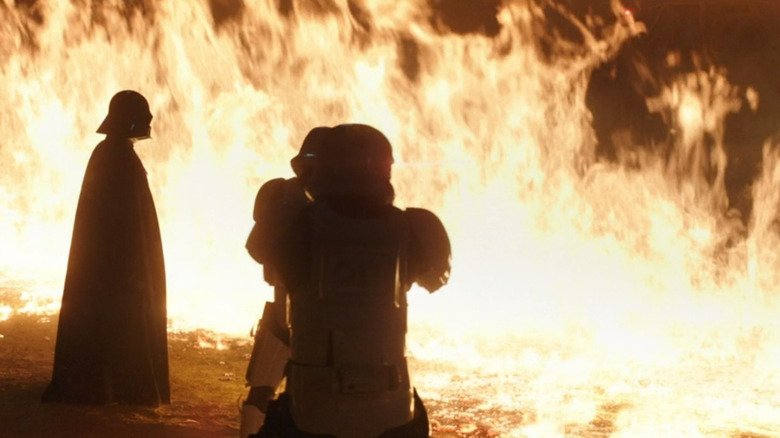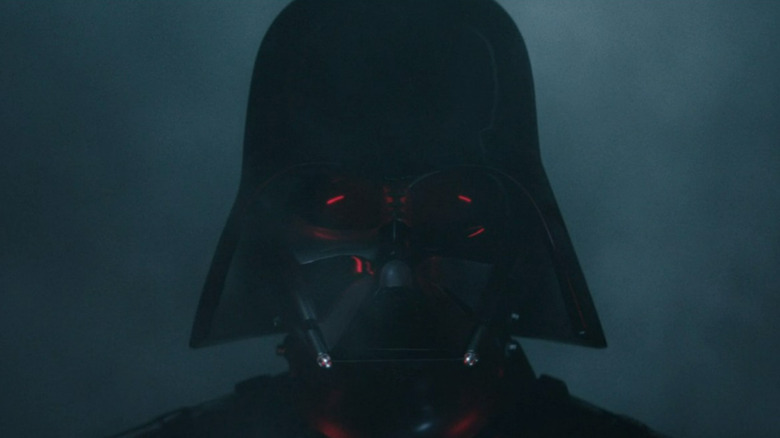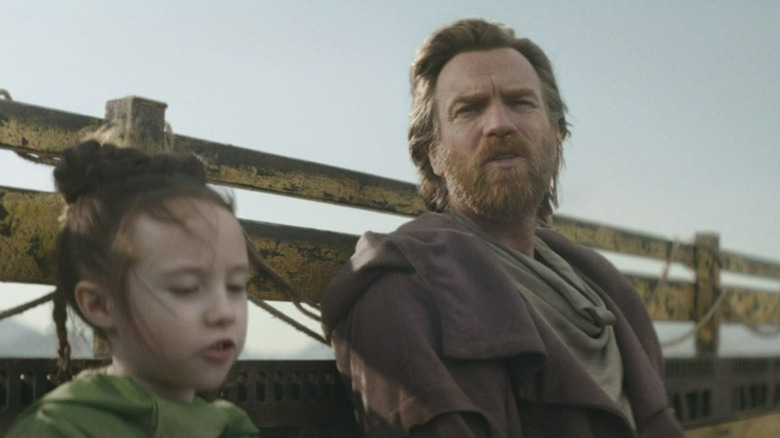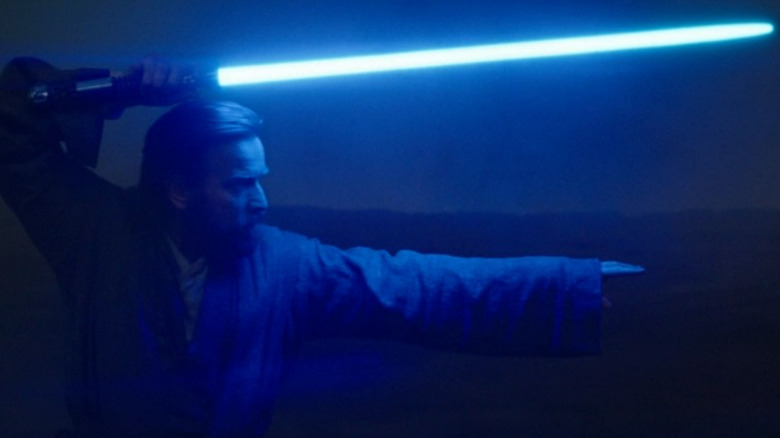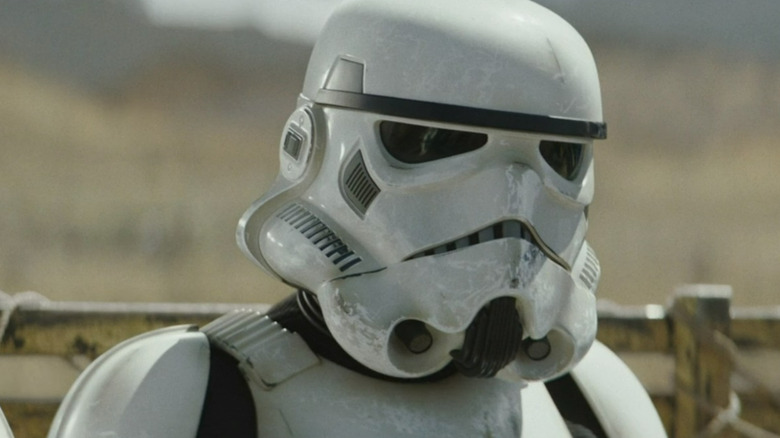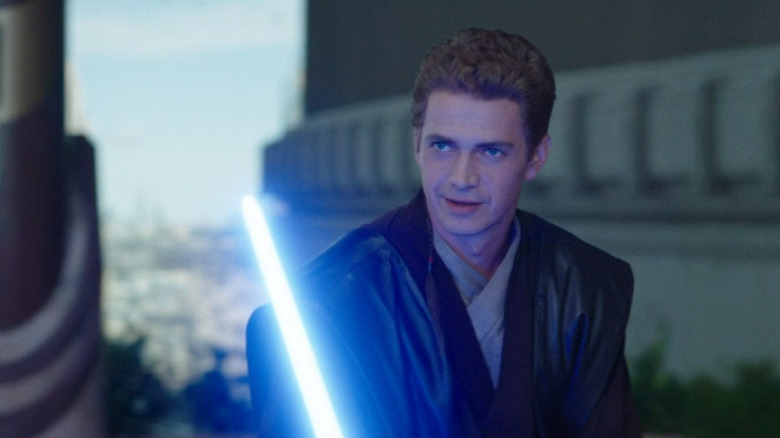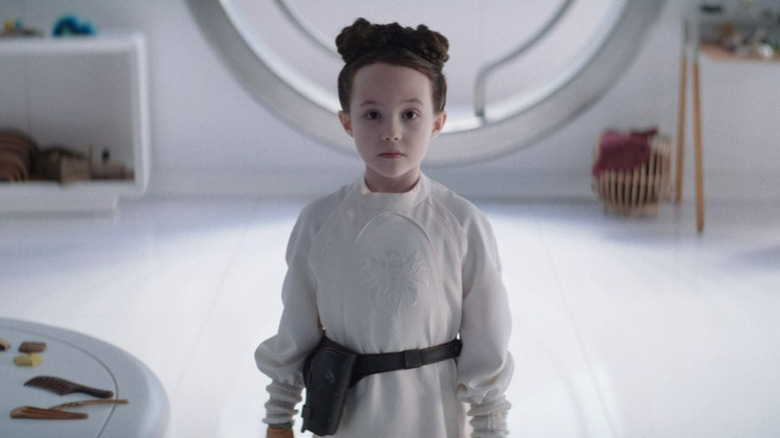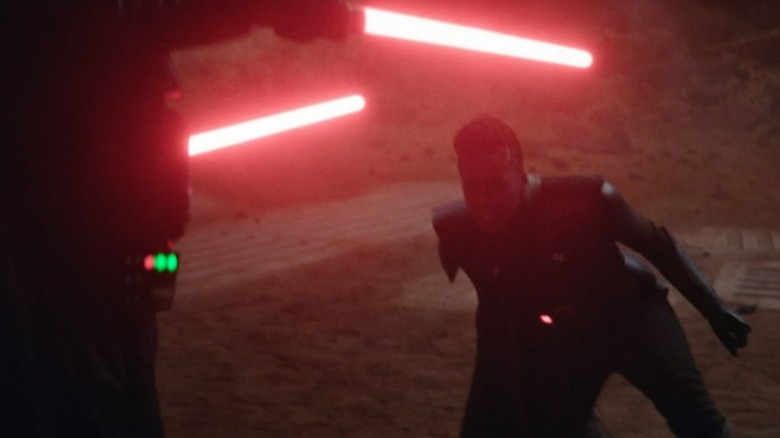The 6 Best And 6 Worst Things About Obi-Wan Kenobi
The "Star Wars" prequels are, at best, deeply flawed movies. That's not a controversial opinion, but it's also not controversial to say that Ewan McGregor's Obi-Wan Kenobi is consistently one of the best parts of the whole trilogy. It makes sense, then, that Disney decided to give the character his own spinoff series on Disney+.
"Obi-Wan Kenobi" occupies a unique space in the "Star Wars" universe. It's the closest Disney has come to returning to the prequel era in live action, even going so far as to bring back Hayden Christensen. And yet, it's not a prequel story. The show spends more time setting up "A New Hope" than it does dealing with the aftermath of "Revenge of the Sith," and the tone is more akin to "Rogue One" than either trilogy. It's a dark story at times, with one of the most in-depth character arcs the franchise has ever had, but it also spends a baffling amount of its brief six-episode run on erroneous subplots. McGregor shines through it all, as does series newcomer Moses Ingram as the Imperial Inquisitor Reva, but there are a lot of glaring issues with "Obi-Wan Kenobi" that feel awkward in the context of the show's blockbuster status.
The journey of Obi-Wan and young Princess Leia (Vivien Lyra Blair) through the galaxy is an uneven one, filled with as many disappointments as exciting moments. Here are the best things about "Obi-Wan Kenobi," as well as the biggest problems that hold it back from true greatness.
Best: Ewan McGregor
Ewan McGregor is excellent in "Obi-Wan Kenobi." It's a very different kind of story for the character than the arc he has in the core "Star Wars" movies, but McGregor still thrives in it. At the beginning of the show, we see an Obi-Wan beaten down by time. The combination of grief, guilt, and isolation has clearly taken its toll on the man, and McGregor conveys this weather-beaten state very well. The original "Star Wars" movie is called "A New Hope," and Obi-Wan is a symbol of that hope — an old war hero who uses his last breaths to reinvigorate the rebellion. And yet, when we meet Obi-Wan in his own show, he looks like he's lost just about all hope.
This is an inherently intriguing setup. Given that "Revenge of the Sith" sees Obi-Wan fail to save the Republic, fail to save the Jedi, and fail to save his best friend, it makes sense for him to be in a pretty dark place. We also know that Obi-Wan is going to find a new lease on life eventually, because when we meet him in "A New Hope," he's fully at peace with his past. Watching the character undertake that journey toward self-forgiveness and acceptance is rewarding and interesting, especially in a "Star Wars" story. The franchise is known more for blockbuster spectacle and big-picture storylines than understated character arcs, but McGregor pulls off Obi-Wan's personal journey with nuance and skill. It's just unfortunate that the script can't keep up with his performance.
Worst: Too much filler
"Obi-Wan Kenobi" is only six episodes long, and they all fall under an hour, yet the show spends a big chunk of time on storylines that feel inescapably like filler. This is most egregious in Episode 4, which consists almost entirely of Tala (Indira Varma) and Obi-Wan's mission to rescue Leia from Fortress Inquisitorius. On paper, it's a fun idea for an episode. The base's aquatic location makes for a cool escape sequence as the tunnels flood, and there's definite appeal in showing a little of the Inquisitors' day-to-day.
The problem is that everything that happens in Episode 4 is a regurgitation. Obi-Wan rescues Leia — which he already did in Episode 2. He gets surprise help from some Jedi sympathizers — just like in Episode 3. We see how driven Reva is to become the Grand Inquisitor — the same as she is in every other episode. And Obi-Wan himself, who's coming off a violent showdown with Darth Vader in Episode 3, barely has any development. It's a huge flop, sacrificing what could have been some meaningful moments of emotional development for an extended, repetitive bout of sneaking around.
This kind of pacing issue pops up on a couple of other occasions in "Obi-Wan Kenobi." It feels at times like the writers were scared of the audience getting bored, but the action they slot in midway through the series isn't especially exciting either. With better pacing, more time could have been spent building up to the handful of climaxes that actually matter.
Best: Moses Ingram
Moses Ingram's Third Sister Reva is the most significant new character introduced in "Obi-Wan Kenobi," and she's also one of the absolute best parts of the show. Her icy persona and violent tendencies harken back to Asajj Ventress in "The Clone Wars," but Reva also feels distinctly like her own character. She doesn't play within the rules of the Empire, and the result is a villain who's nearly as intriguing to watch as the man the show is named after.
There's always been a lot of talk in the "Star Wars" movies about how people turn to the dark side, but it's rarely shown in live action. Palpatine, Maul, Dooku, even Kylo Ren — all these bad guys become evil before their stories start, and only Kylo gets any real explanation of how and why he turned. Vader is the best example of a full dark side arc in the movies, but his is different because it's also the main story of the entire saga.
Reva, on the other hand, feels fully convincing as someone who slowly fell down the hole of the dark side. Her motivations are clear, and it's easy to see why, in the harsh world she's had to live in, she embraced evil behavior in order to survive. Some of this is obviously due to the script, but Ingram deserves most of the credit. She imbues every scene with an intense sense of pain, creating a character who's as tortured as she is torturous.
Worst: Sloppy writing
You can nitpick while watching any movie or TV show if you look hard enough. Writers make mistakes, and logic often takes a backseat to storytelling. When the storytelling is great, that's not really a problem. We don't tend to complain about deus ex machinas or convenient coincidences as much when the end result is an entertaining tale. It takes a lot of these little nitpicky mistakes to truly harm the quality of a story, but sadly, that's exactly what happens in "Obi-Wan Kenobi."
There are just too many instances of sloppy or lazy writing to ignore. How do Obi-Wan and Tala manage to get away from Vader so quickly on Mapuzo? Why are there no security cameras in Fortress Inquisitorius? Why can't the patrolling probe droids detect Obi-Wan's presence with non-visual sensors? Why does everybody say secret things so loudly when they're around so many other people, and how do they never get overheard? Why does Bail Organa send Obi-Wan a physical transmission revealing Anakin's children and their locations? How does Reva survive her fight with Vader and get to Tatooine so quickly? And above all, why do characters keep thinking their enemies are dead when they are clearly not? Seriously, it happens four times in the show — to the Grand Inquisitor, Reva, Obi-Wan, and Vader. It's like no one understands what a killing blow is.
Individually, these aren't the kinds of mistakes that ruin a show. But "Obi-Wan Kenobi" insists on making lazy writing choices again and again, and it just becomes too much.
Best: Darth Vader
Do you like Darth Vader? Of course you do. At this point, he's probably the most unifying part of the entire "Star Wars" franchise. It's hard to find a fan who doesn't love Darth Vader, which means that letting him do some cool stuff is almost always a good idea. And in "Obi-Wan Kenobi," Darth Vader does some pretty cool stuff.
The combo of James Earl Jones and Hayden Christensen works really well here, and it allows for an oscillation between the Vader persona and Anakin himself. The scene in Episode 6 where Obi-Wan slashes through Vader's helmet and the two actors' voices muddle together is particularly effective. Anakin is a huge part of Obi-Wan's story, and he's used to great effect throughout, both in his moments of titanic action and as an emotional foil to his old master.
We could spend all day talking about how terrifying Vader is in the Mapuzo scenes, or about how he beats Reva without ever using his own lightsaber, or about how he tears a spaceship out of the sky with one hand, but then we'd just be saying what everybody already knows. Darth Vader is one of the greatest villains of all time, and he continues to be that in "Obi-Wan Kenobi."
Worst: Trapped by the past
There once was a time when the two decades between "Revenge of the Sith" and "A New Hope" were largely unexplored. These days, though, that's no longer the case. Between animated series like "Star Wars Rebels" and "The Bad Batch," movies like "Rogue One" and "Solo," and videogames like "Star Wars Jedi: Fallen Order," a lot of those years have been filled out with exciting side stories. "Obi-Wan Kenobi" tries to squeeze yet another arc into that timeframe, and it frequently bumps its head on the ceiling.
Simply put, it's hard to give stakes to a story when the main characters' fates are all known. Leia, Obi-Wan, and Vader are all safe from death, and while that isn't necessarily a problem (it was also true in the prequel trilogy, after all), it doesn't help matters. Other than Reva, the new side characters introduced in Obi-Wan don't get much development. Tala, Roken (O'Shea Jackson Jr.), and Haja (Kumail Nanjiani) are all played well, but they are more symbols of the rebellion as a whole than they are properly developed characters in their own right. That makes the limitations placed on the older characters even more restrictive.
Even when Obi-Wan is infiltrating an Imperial facility used to torture Jedi, it's hard to feel the tension. The most important stories from his life have already been told, after all, and the show struggles repeatedly to create a new legacy for itself.
Best: A darker Star Wars story
While you may never worry for Obi-Wan's life in "Obi-Wan Kenobi," that doesn't mean that the show is bright and cheery. The Disney+ series shows a pretty dark version of the "Star Wars" universe, which makes sense given when the story takes place. This is a grim time for the galaxy — one where Darth Vader can just show up on your planet and yank you to death with the Force. From Reva's intimidation tactics on Tatooine to the desperation seen on Daiyu, the series does an effective job of showing just how bad things are under the Empire.
The dark tone of "Obi-Wan Kenobi" also works well in the main character's personal arc. At the start of Episode 1, Obi-Wan is largely cut off from the Force, and he hesitates to use it (as well as his lightsaber) for multiple episodes. He clearly has some severe trauma from the events of Order 66, and he has constant nightmares about his battle with Anakin on Mustafar. After watching Obi-Wan mostly deal with tangible problems in the prequels, it's compelling to see him grappling with more internal issues for a change.
Order 66 is also dealt with in pretty heavy ways through Reva's arc, which is powerful in its own right. Overall, "Obi-Wan Kenobi" shows the evil of the Empire more through the fear of its citizens than through the actions of its soldiers, and that ends up being quite effective.
Worst: Lack of style
There are some moments in "Obi-Wan Kenobi" that absolutely nail it in terms of style. Daiyu is a fun new planet with a ton of personality, and the entirety of Episode 2 (which is spent there) vibrates with energy and excitement as a result. There are also a number of exciting action scenes, with Vader's fight against Reva and Obi-Wan's flashback duel with Anakin standing out in particular. Unfortunately, though, a lot of the rest of the show suffers from a lack of style.
Maybe it's just fatigue after so much time spent there in "The Mandalorian" and "The Book of Boba Fett," but it's hard to get excited about Tatooine anymore. Yes, it's central to Obi-Wan's story, so it makes sense that he spends some time there, but the show doesn't do much to make the planet any more interesting. Most of the places he goes to afterwards are equally dull — rocky hills and fields on Mapuzo, rocky caves on Jabiim, and even a pretty nondescript locale for Obi-Wan and Vader's climactic battle. Even the fights themselves lack some of the style and memorability that fans have come to expect from the franchise, which is a real shame.
Again, "Obi-Wan Kenobi" does not fully lack style, but for a show that's only six episodes long, it feels disappointingly unambitious.
Best: Fan service
As it is a "Star Wars" story, "Obi-Wan Kenobi" has a lot of Easter eggs and fan service. And fortunately, a lot of it is pretty good. It's cool to see Joel Edgerton and Bonnie Piesse return as Owen and Beru Lars, and Edgerton in particular channels Phil Brown's Owen from "A New Hope" very well. It's even more fun to see Ian McDiarmid and Liam Neeson pop up briefly as Emperor Palpatine and Qui-Gon Jinn.
The Leia storyline also opens up some fun opportunities, like finally showing what Alderaan was like in live action before it was obliterated by the Death Star. Jimmy Smits is great once again as Bail Organa, and it's interesting to see him and Obi-Wan interacting in the thick of the Imperial era. There are snowspeeders, bowcasters, thermal detonators, Star Destroyers, references to old Jedi, and a lot of flashback scenes to the prequel era. And then, of course, there's all the fighting.
The fight between Obi-Wan and Anakin (set before "Attack of the Clones") is a definite highlight in the fan service department, and it's arguably the best lightsaber fight in the whole show. Christensen and McGregor still have great chemistry, and they make what's ostensibly just a training duel into a tense battle. And, of course, there are plenty of classic lines scattered across the series, with Obi-Wan's iconic "Hello there!" being a distinct standout.
Worst: Leia isn't a real character
For as good as Vivien Lyra Blair is as Leia Organa, the character suffers from writing that treats her more like an Easter egg than a person. She's only nine, yet she carries herself with the confidence and discernment of a seasoned general. Obviously, Leia is an impressive person in the "Star Wars" universe, and the show's writers clearly want to treat both her and Carrie Fisher's legacy with respect. But wouldn't it be more respectful to make young Leia a real character?
Even when she's being interrogated in an Imperial prison, Leia never breaks — a nine-year-old girl, who believes that her only friend in the galaxy is dead, in a prison literally designed to break Jedi. It would be interesting if Leia broke at times; it would give Obi-Wan a chance to console her and step up as the adult in the room. But no, she never breaks, and he never gets that opportunity.
This wouldn't matter so much if Leia weren't such a massive part of the story. Most of Obi-Wan's scenes are related to her in some way, and a lot of his dialogue is spoken directly to her. But because she doesn't have a real arc, it often feels awkward when it should feel cute.
Best: The action
For all its dour contemplation of failure and internal emotional arcs, "Obi-Wan Kenobi" still has plenty of action to keep viewers engaged, and a lot of it is really good. The chase scene at the end of Episode 2 is a fun early moment, showing Reva's impressive powers while also making use of the Daiyu rooftops. Obi-Wan's brief skirmish with Stormtroopers on Mapuzo is a surprisingly brutal encounter for the Jedi, and it drives home just how determined he is to protect Anakin's children. And the escape sequence in Episode 5 is a tense, claustrophobic battle that shows just how scary Stormtroopers can actually be.
But of course, the real highlights here are the lightsaber battles, and there are a bunch of them. Obi-Wan and Anakin get three in total — two in the main timeline, post-Vader transformation, and one in a prequel era flashback. They're all exciting in different ways, though the final showdown ends with a frustratingly convenient victory for Obi-Wan. Vader's cocky, sure, but is he so cocky that he'd let Obi-Wan get the drop on him and dismantle him so easily? Regardless, it's still a fun fight, and it gives the two former friends a nice moment of closure.
Perhaps the best action scene in the whole show, however, is Vader's battle with Reva. It's a brutal duel that emphasizes just how strong the Sith Lord actually is, and it's some of the best fight choreography in the series.
Worst: Squandered potential
The most disappointing thing about "Obi-Wan Kenobi" isn't that it's bad, because it's not. The most disappointing thing about the show is that it could — and should — have been so much better. The writing should have been cleaner, the pacing should have been tighter, and it should have stuck the landing better than it ultimately does. What we end up getting is a show that, like "The Book of Boba Fett," falls short of its true potential.
There are a lot of little things that could have been handled better. Plot developments like Reva's escape to Tatooine and Obi-Wan's victory over Vader could have been dealt with in more satisfying and convincing ways. Leia could have been given an actual arc instead of just existing to ask Obi-Wan questions. But most importantly, Obi-Wan's own arc — the basis for the entire show — should have wrapped up in a more complete way.
Obi-Wan's arc is basically as follows: He loses hope in the future and faith in himself, and by connecting with Leia, he remembers why the fight is still worthwhile. It's not that complicated. And yet, the show sort of loses the plot toward the end. His big moment of change is when he decides to face Vader again, declaring that he'll either die or kill Vader for good. But neither of those things end up happening. He faces his demons and makes peace with them, but because of the Reva plotline, he doesn't have much opportunity to show that change. Even Qui-Gon only shows up for a couple of lines. Does it work? Yes. Is it great? No. And sadly, that sentiment applies to the entirety of "Obi-Wan Kenobi."
